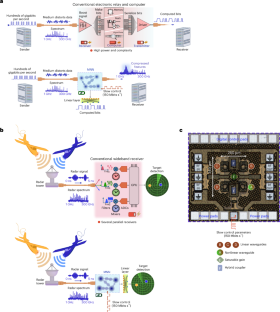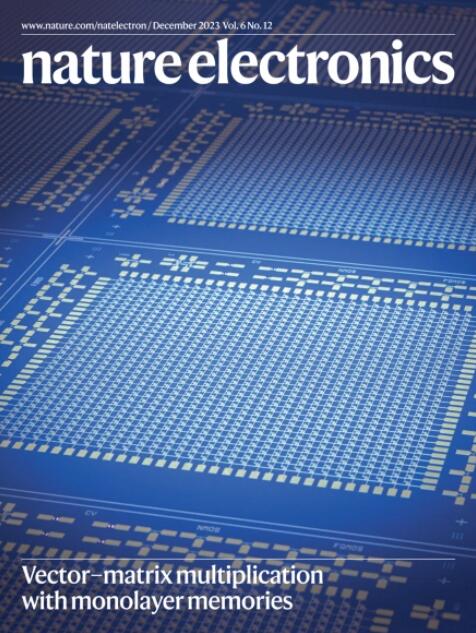An integrated microwave neural network for broadband computation and communication
IF 40.9
1区 工程技术
Q1 ENGINEERING, ELECTRICAL & ELECTRONIC
引用次数: 0
Abstract
The development of high-bandwidth applications, including multi-gigabit communication and radar imaging, demands faster processing. However, in the microwave regime, where frequencies exceed clock rates, sampling and computation become challenging. Here we report an integrated microwave neural network for broadband computation and communication. Our microwave neural network operates across tens of gigahertz but is reprogrammed with slow megabits per second control bitstreams. By exploiting strong nonlinearity in coupled microwave oscillations, it expresses its computation in a narrower spectrum, enabling easy read-out. The system searches bit sequences in multi-gigabits per second data and emulates digital functions without custom circuits. It accelerates radio-frequency machine learning by classifying encoding schemes and detecting frequency shifts to track flight trajectories from radar. The microwave neural network is fabricated with standard complementary metal–oxide–semiconductor technology. It occupies a sub-wavelength footprint of 0.088 mm2 on chip and has a sub-200-mW power consumption, supporting integration in a general-purpose analogue processor. A low-power microwave neural network fabricated using complementary metal–oxide–semiconductor technology can perform broadband computations using a slow control mechanism.


用于宽带计算与通信的集成微波神经网络
高带宽应用的发展,包括多千兆通信和雷达成像,需要更快的处理速度。然而,在频率超过时钟速率的微波环境中,采样和计算变得具有挑战性。本文报道了一种用于宽带计算和通信的集成微波神经网络。我们的微波神经网络在几十千兆赫的范围内运行,但以每秒兆比特的慢速控制比特流重新编程。它利用耦合微波振荡的强非线性,在较窄的频谱中表达其计算,使其易于读出。该系统以每秒数千兆比特的数据搜索位序列,并在没有定制电路的情况下模拟数字功能。它通过分类编码方案和检测频率变化来加速射频机器学习,从而从雷达跟踪飞行轨迹。微波神经网络采用标准的互补金属氧化物半导体技术制备。它在芯片上占据0.088 mm2的亚波长,功耗低于200兆瓦,支持集成在通用模拟处理器中。
本文章由计算机程序翻译,如有差异,请以英文原文为准。
求助全文
约1分钟内获得全文
求助全文
来源期刊

Nature Electronics
Engineering-Electrical and Electronic Engineering
CiteScore
47.50
自引率
2.30%
发文量
159
期刊介绍:
Nature Electronics is a comprehensive journal that publishes both fundamental and applied research in the field of electronics. It encompasses a wide range of topics, including the study of new phenomena and devices, the design and construction of electronic circuits, and the practical applications of electronics. In addition, the journal explores the commercial and industrial aspects of electronics research.
The primary focus of Nature Electronics is on the development of technology and its potential impact on society. The journal incorporates the contributions of scientists, engineers, and industry professionals, offering a platform for their research findings. Moreover, Nature Electronics provides insightful commentary, thorough reviews, and analysis of the key issues that shape the field, as well as the technologies that are reshaping society.
Like all journals within the prestigious Nature brand, Nature Electronics upholds the highest standards of quality. It maintains a dedicated team of professional editors and follows a fair and rigorous peer-review process. The journal also ensures impeccable copy-editing and production, enabling swift publication. Additionally, Nature Electronics prides itself on its editorial independence, ensuring unbiased and impartial reporting.
In summary, Nature Electronics is a leading journal that publishes cutting-edge research in electronics. With its multidisciplinary approach and commitment to excellence, the journal serves as a valuable resource for scientists, engineers, and industry professionals seeking to stay at the forefront of advancements in the field.
 求助内容:
求助内容: 应助结果提醒方式:
应助结果提醒方式:


